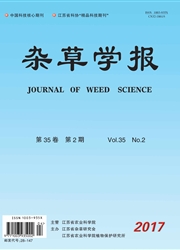

 中文摘要:
中文摘要:
对6个谷子品种进行盆栽试验,研究不同浓度稀禾啶处理对不同品种谷子的影响。测定株高、茎粗、叶面积、鲜质量等生长状况及相关的生理生化指标。结果表明,稀禾啶对大部分谷子生长有一定的抑制作用,从生长状态上看张杂谷抗药性要强于普通品种。不同浓度稀禾啶对同一品种谷子的生理指标影响是有差异的。不同浓度稀禾啶对不同谷子品种影响差异较大,当稀禾啶浓度为0.80 m L/L时,叶绿素相对含量与对照组差异不显著。稀禾啶浓度为1.00 m L/L时,张杂谷叶绿素相对含量与对照组差异不显著,而普通品种叶绿素相对含量与对照的差异均达到0.05显著水平。稀禾啶药剂处理后,谷子品种的POD酶活性有所提高,而其SOD酶活性先升高后降低,表明不同谷子品种耐药性差异较大,推荐剂量使用后对张杂谷仍有抑制作用,并可导致苗期死亡。因此,3-5叶期使用应降低剂量。
 英文摘要:
英文摘要:
Six varieties millet were tested in pot experiments by treating then with sethoxydim at different concentrations and determining their physiological(stem diameter,plant height,leaf area and fresh weight) and biochemical indexes.Growth of most millets is inhibited to certain extent by sethoxydim. Based on overall growth,Zhangzagu millet is more tolerant than common varieties. Physiological indicators varied with sethoxydim concentration within a variety,with varieties responding differently to the herbicide. Sethoxydim at 0. 8 m L/L had practically no effect on the relative chlorophyll content compared to that of untreated plants. When sethoxydim concentration was 1 m L/L,the relative chlorophyll content of zhangzagu millets was similar to that of the control group,but the relative content of chlorophyll of the common varieties was significantly lower than the control group at 0. 05 level. After spraying sethoxydim,POD activities of millet increased,and the SOD activities firstly increased and then decreased,indicating that there was a wide variation in herbicide tolerance among the different millets. The Zhangzagu millets were inhibited by sethoxydim at the recommended dose,which could be lethal. Therefore,sethoxydim should be carefully used or may be not recommendedto millet fields at the 3 - 5 leaves stage.
 同期刊论文项目
同期刊论文项目
 同项目期刊论文
同项目期刊论文
 期刊信息
期刊信息
